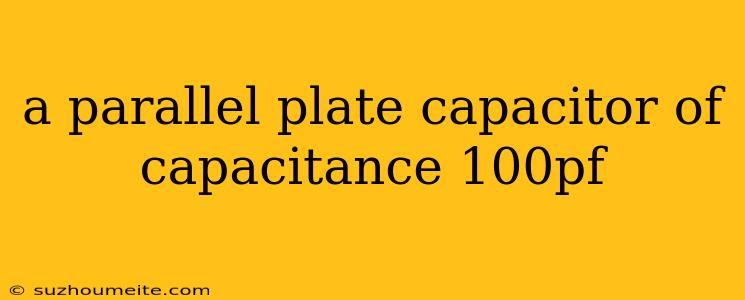A Parallel Plate Capacitor of Capacitance 100 pF
A parallel plate capacitor is a fundamental component in electronics and electrical engineering. It consists of two conductive plates separated by a non-conductive material called a dielectric. The capacitance of this device is determined by the geometry of the plates and the type of dielectric used. In this case, we'll explore a parallel plate capacitor with a capacitance of 100 pF.
Understanding Capacitance
Capacitance (C) is the ability of a device to store electrical energy in the form of an electric field. It's measured in Farads (F), although smaller units like picofarads (pF) are more commonly used. For a parallel plate capacitor, the capacitance is calculated using the following formula:
C = ε₀ * εr * A / d
Where:
- C: Capacitance (in Farads)
- ε₀: Permittivity of free space (approximately 8.85 x 10⁻¹² F/m)
- εr: Relative permittivity (dielectric constant) of the material between the plates
- A: Area of each plate (in square meters)
- d: Distance between the plates (in meters)
The 100 pF Capacitor
A 100 pF capacitor can be constructed with various combinations of plate area, dielectric material, and plate separation. Let's consider a few possibilities:
Example 1:
- Dielectric: Air (εr ≈ 1)
- Plate Area (A): 10 cm² = 10⁻³ m²
- Distance (d): We can calculate the necessary distance using the formula:
d = ε₀ * εr * A / C
d = 8.85 x 10⁻¹² * 1 * 10⁻³ / 100 x 10⁻¹²
d = 8.85 x 10⁻⁵ m = 88.5 μm
This means that to achieve 100 pF capacitance with air as the dielectric and a plate area of 10 cm², the plates need to be separated by approximately 88.5 micrometers.
Example 2:
- Dielectric: Ceramic (εr ≈ 100)
- Plate Area (A): 1 cm² = 10⁻⁴ m²
- Distance (d): We can again calculate the necessary distance:
d = ε₀ * εr * A / C
d = 8.85 x 10⁻¹² * 100 * 10⁻⁴ / 100 x 10⁻¹²
d = 8.85 x 10⁻⁴ m = 0.885 mm
Using a ceramic dielectric with a higher permittivity allows for a larger plate separation (0.885 mm) while maintaining the same capacitance.
Applications of 100 pF Capacitors
100 pF capacitors are frequently used in various electronic circuits, including:
- High-frequency filters: Capacitors are essential for filtering out unwanted frequencies, and 100 pF capacitors are often used in high-frequency applications.
- Coupling circuits: They can be used to connect different parts of a circuit while blocking DC currents.
- Oscillators: 100 pF capacitors are often found in oscillator circuits, which generate specific frequencies.
- Tuning circuits: They are used in radio receivers and transmitters for selecting specific frequencies.
Conclusion
A parallel plate capacitor with a capacitance of 100 pF can be constructed using different materials and geometries. The specific parameters depend on the desired application and the required performance characteristics. Understanding the factors that influence capacitance is crucial for designing and utilizing these components effectively in various electronic circuits.
